
AdventureLog is a simple way to log your travels and share them with the world. You can add photos, notes, and more to your logs. Keep track of the countries you’ve visited, the regions you’ve explored, and the places you’ve been. You can also see your travel stats and milestones. In this step by step guide I will show you how to install AdventureLog on your Synology NAS using Docker & Portainer.
STEP 1
Please Support My work by Making a Donation.
STEP 2
Install Portainer using my step by step guide. If you already have Portainer installed on your Synology NAS, skip this STEP. Attention: Make sure you have installed the latest Portainer version.
STEP 3
Go to Control Panel / Network / Connectivity tab/ Check Enable HTTP/2 then click Apply. Follow the instructions in the image below.
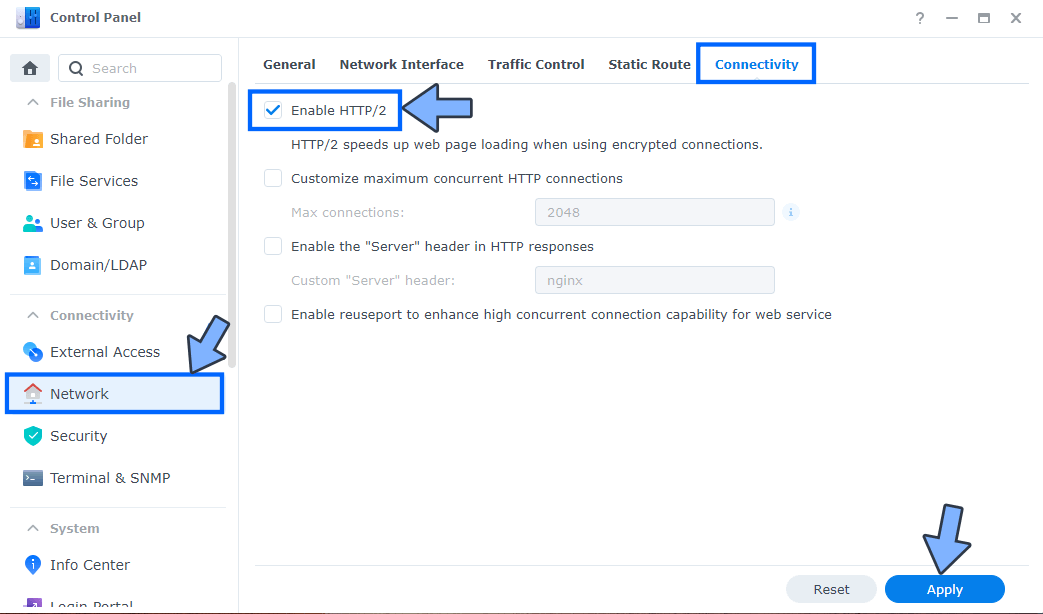
STEP 4
Go to Control Panel / Security / Advanced tab/ Check Enable HTTP Compression then click Apply. Follow the instructions in the image below.
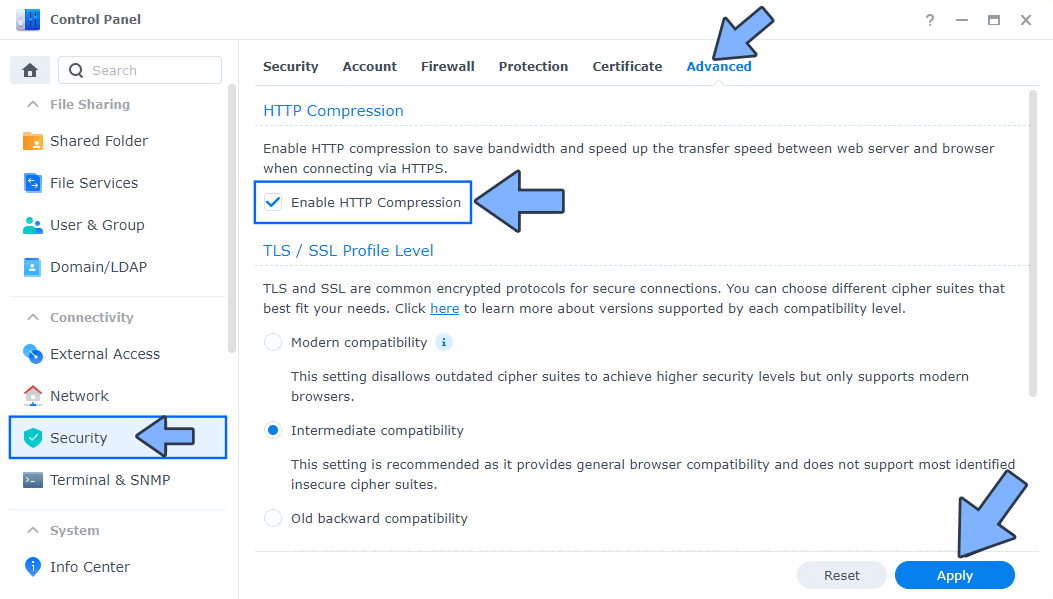
STEP 5
Make sure you have a synology.me Wildcard Certificate. Follow my guide to get a Wildcard Certificate. If you already have a synology.me Wildcard certificate, skip this STEP.
STEP 6
Go to Control Panel / Login Portal / Advanced Tab / click Reverse Proxy. Follow the instructions in the image below.
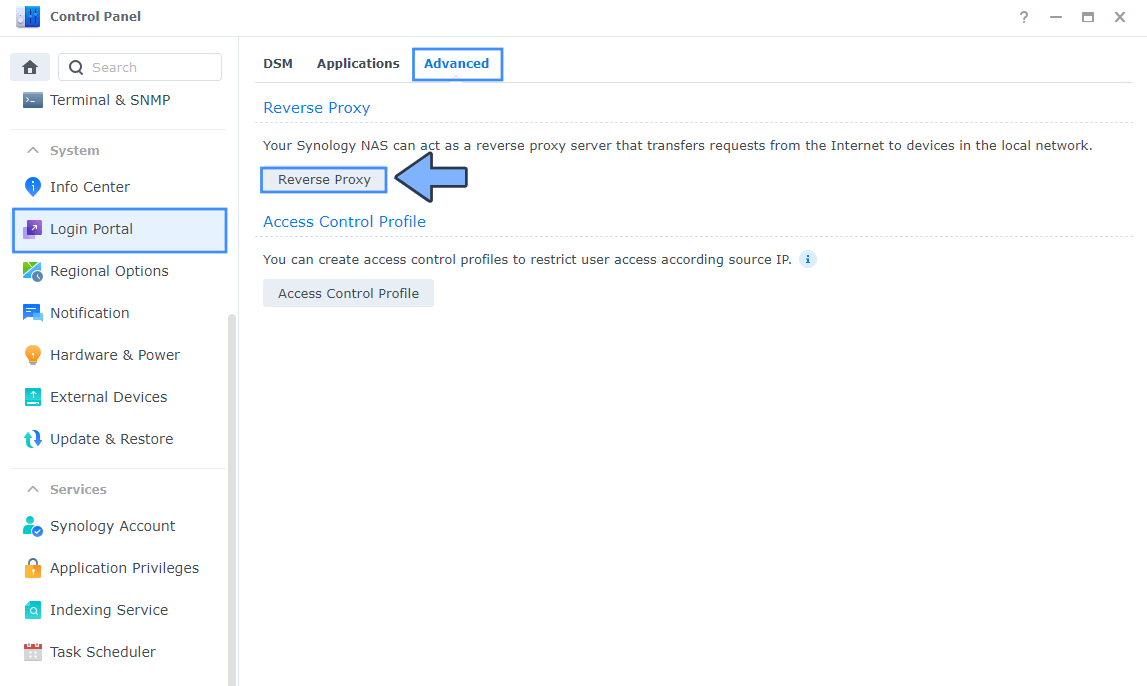
STEP 7
Now click the “Create” button. Follow the instructions in the image below.

STEP 8
After you click the Create button, the window below will open. Follow the instructions in the image below.
On the General area, set the Reverse Proxy Name description: type in AdventureLog. After that, add the following instructions:
Source:
Protocol: HTTPS
Hostname: adventurelog.yourname.synology.me
Port: 443
Check Enable HSTS
Destination:
Protocol: HTTP
Hostname: localhost
Port: 9866
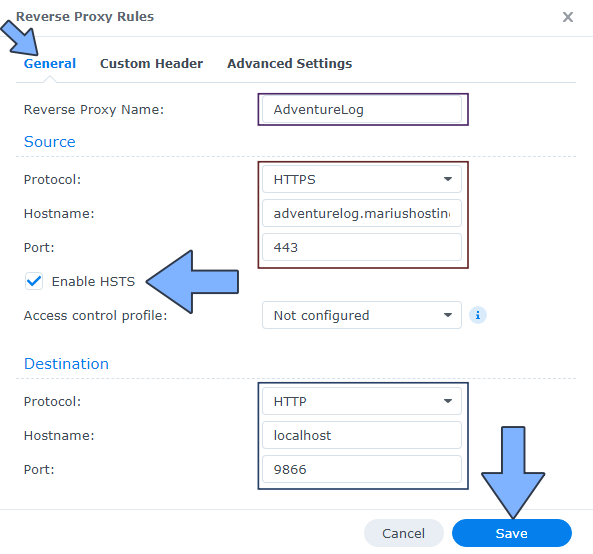
STEP 9
On the Reverse Proxy Rules click the Custom Header tab. Click Create and then, from the drop-down menu, click WebSocket. After you click on WebSocket, two Header Names and two Values will be automatically added. Click Save. Follow the instructions in the image below.

STEP 10
Go to Control Panel / Login Portal / Advanced Tab / click Reverse Proxy. Follow the instructions in the image below.
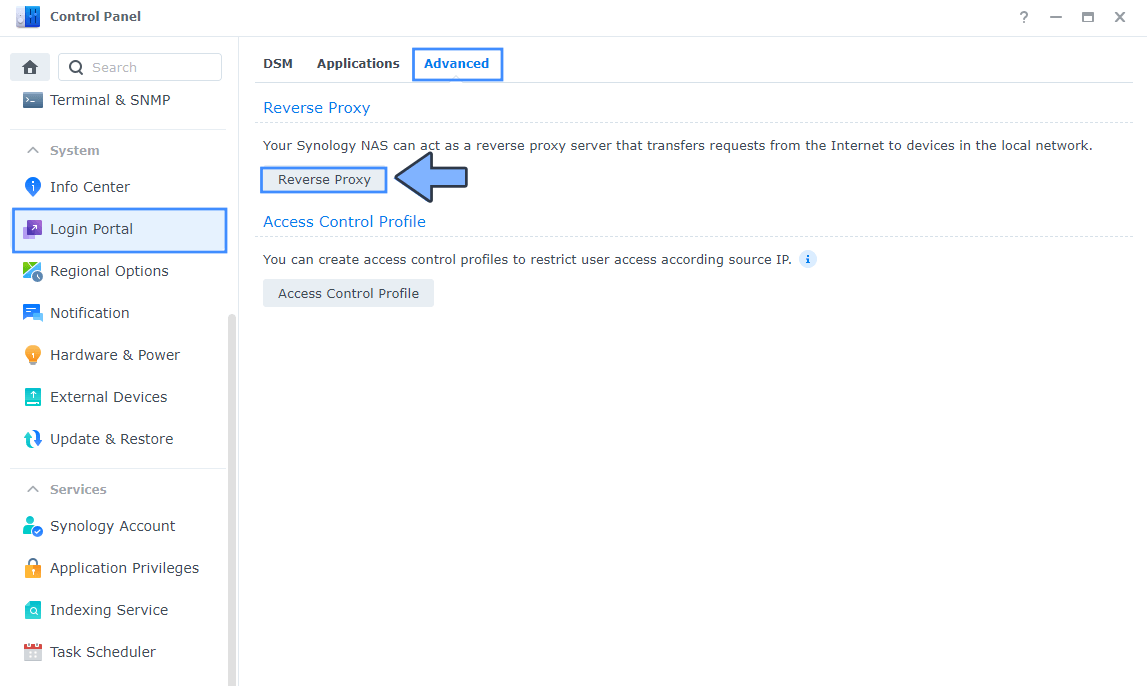
STEP 11
Now click the “Create” button. Follow the instructions in the image below.
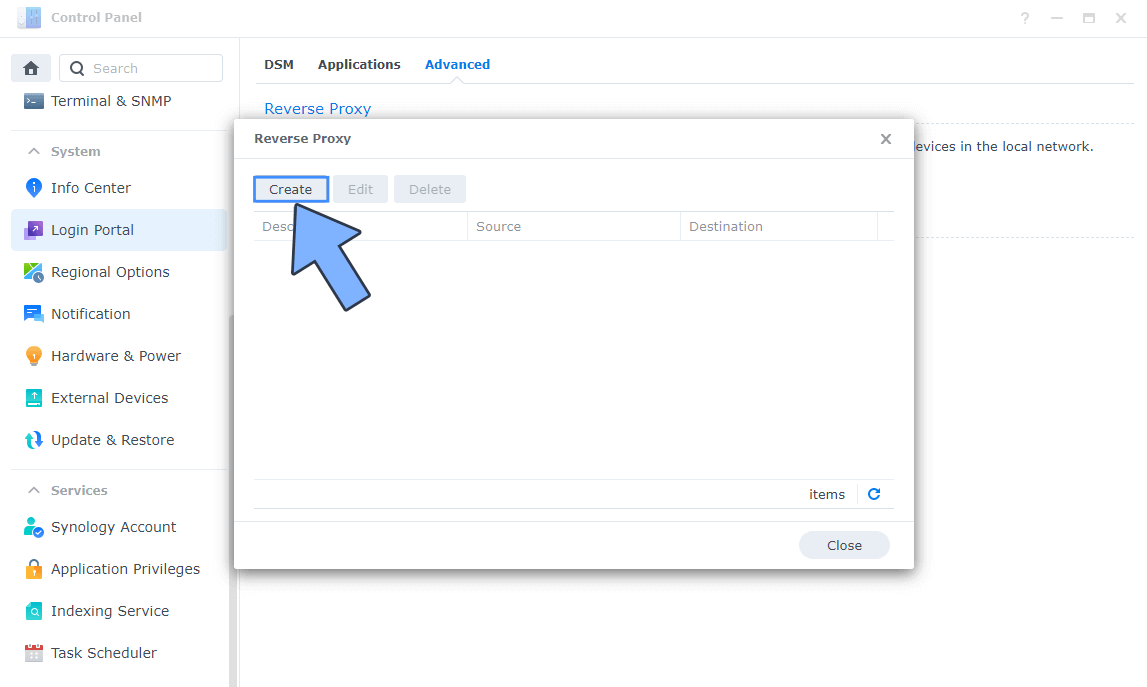
STEP 12
After you click the Create button, the window below will open. Follow the instructions in the image below.
On the General area, set the Reverse Proxy Name description: type in AdventureLog-API. After that, add the following instructions:
Source:
Protocol: HTTPS
Hostname: adventurelogapi.yourname.synology.me
Port: 443
Check Enable HSTS
Destination:
Protocol: HTTP
Hostname: localhost
Port: 8669
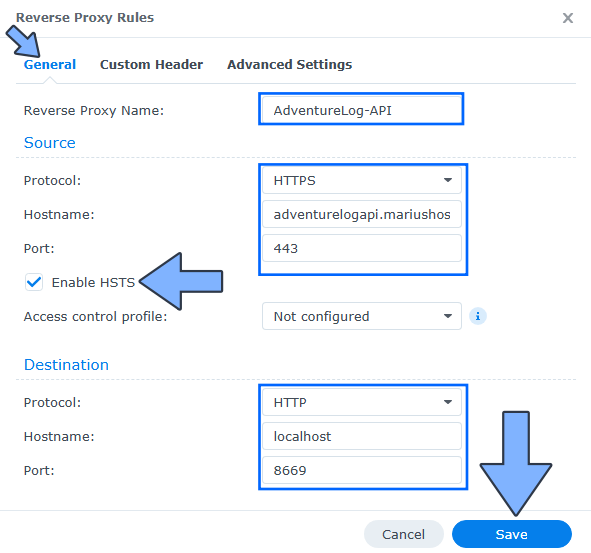
STEP 13
On the Reverse Proxy Rules click the Custom Header tab. Click Create and then, from the drop-down menu, click WebSocket. After you click on WebSocket, two Header Names and two Values will be automatically added. Click Save. Follow the instructions in the image below.

STEP 14
Go to File Station and open the docker folder. Inside the docker folder, create two new folders and name them adventurelog. Follow the instructions in the image below.
Note: Be careful to enter only lowercase, not uppercase letters.
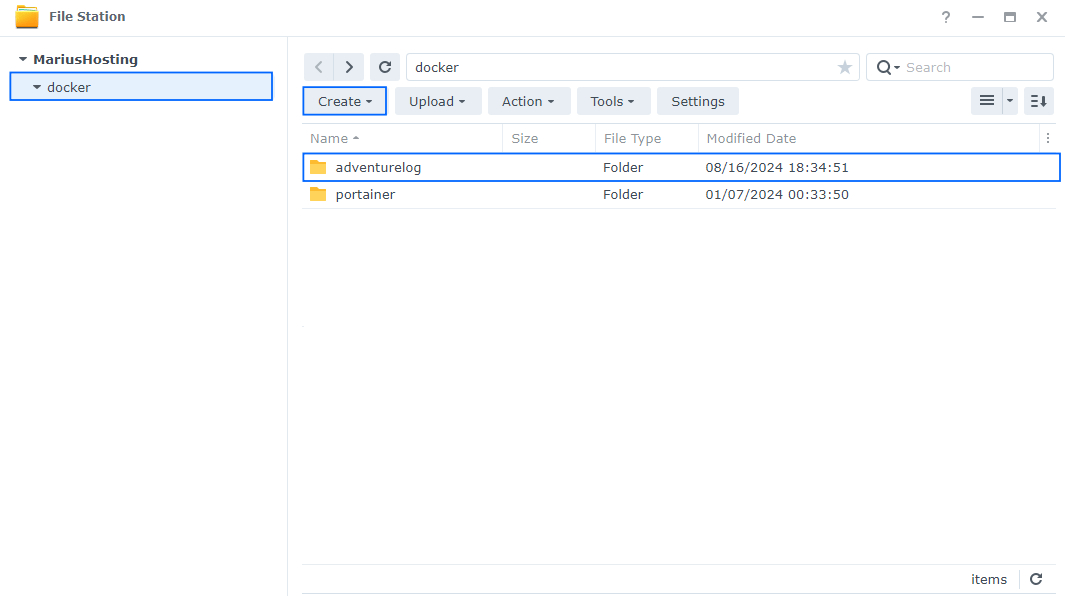
STEP 15
Go to File Station and open the docker folder. Inside the adventurelog folder, create two new folders and name them db and media. Follow the instructions in the image below.
Note: Be careful to enter only lowercase, not uppercase letters.
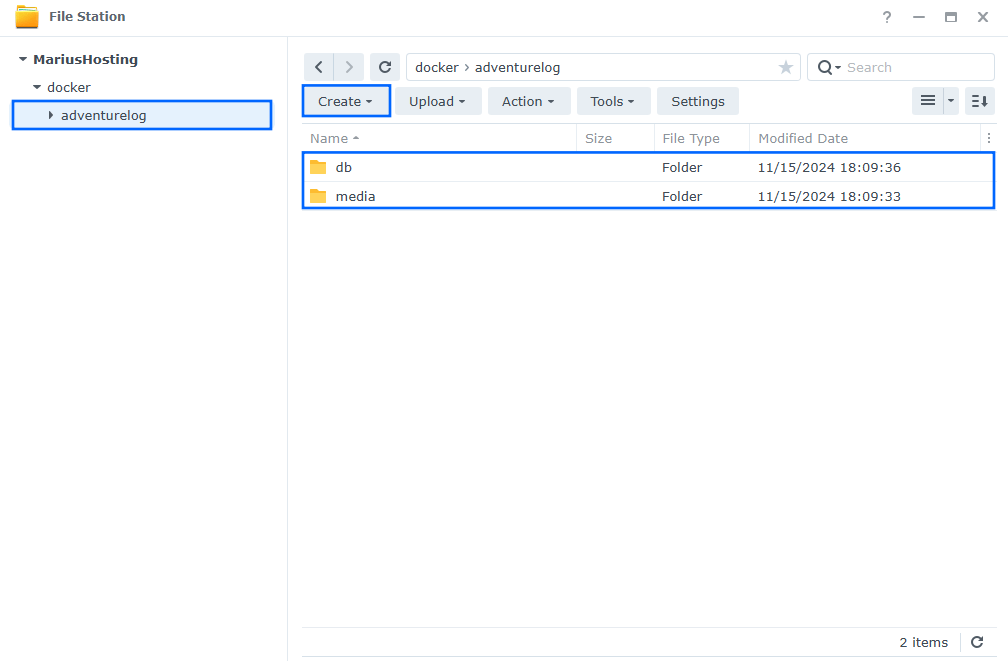
STEP 16
Log into Portainer using your username and password. On the left sidebar in Portainer, click on Home then Live connect. Follow the instructions in the image below.

On the left sidebar in Portainer, click on Stacks then + Add stack. Follow the instructions in the image below.

STEP 17
In the Name field type in adventurelog. Follow the instructions in the image below.
services:
db:
image: postgis/postgis:16-master
container_name: AdventureLog-DB
hostname: adventurelog-db
mem_limit: 1g
cpu_shares: 1024
security_opt:
- no-new-privileges:true
healthcheck:
test: ["CMD", "pg_isready", "-q", "-d", "adventurelog", "-U", "adventureloguser"]
timeout: 45s
interval: 10s
retries: 10
volumes:
- /volume1/docker/adventurelog/db:/var/lib/postgresql/data:rw
environment:
POSTGRES_DB: adventurelog
POSTGRES_USER: adventureloguser
POSTGRES_PASSWORD: adventurelogpass
restart: on-failure:5
web:
image: ghcr.io/seanmorley15/adventurelog-frontend:latest
container_name: AdventureLog-FRONTEND
environment:
- PUBLIC_SERVER_URL=http://server:8000
- ORIGIN=https://adventurelog.yourname.synology.me
- BODY_SIZE_LIMIT=Infinity
ports:
- 9866:3000
depends_on:
- server
server:
image: ghcr.io/seanmorley15/adventurelog-backend:latest
container_name: AdventureLog-SERVER
healthcheck:
test: timeout 10s bash -c ':> /dev/tcp/127.0.0.1/80' || exit 1
interval: 10s
timeout: 5s
retries: 3
start_period: 90s
environment:
- PGHOST=db
- PGDATABASE=adventurelog
- PGUSER=adventureloguser
- PGPASSWORD=adventurelogpass
- SECRET_KEY=q9TAW5pK5O9DqAWhY18XupmtlZk0ULRmjroiZcfvJkvZduSYzrzc0FtM2yfHEeyB
- DJANGO_ADMIN_USERNAME=marius
- DJANGO_ADMIN_PASSWORD=mariushosting
- DJANGO_ADMIN_EMAIL=yourown@email
- DISABLE_REGISTRATION=false
- PUBLIC_URL=https://adventurelogapi.yourname.synology.me
- CSRF_TRUSTED_ORIGINS=https://adventurelog.yourname.synology.me, https://adventurelogapi.yourname.synology.me
- DEBUG=False
- FRONTEND_URL=https://adventurelog.yourname.synology.me
ports:
- 8669:80
depends_on:
- db
volumes:
- /volume1/docker/adventurelog/media:/code/media:rw
Note: Before you paste the code above in the Web editor area below, change the value for ORIGIN and type in your own synology.me DDNS with https:// at the beginning that you have previously created at STEP 8.
Note: Before you paste the code above in the Web editor area below, change the value for SECRET_KEY and add your own SECRET KEY. (Generate your own 64 length SECRET_KEY.)
Note: Before you paste the code above in the Web editor area below, change the value for DJANGO_ADMIN_USERNAME and type in your own username. marius is an example for a username. Do NOT use special characters.
Note: Before you paste the code above in the Web editor area below, change the value for DJANGO_ADMIN_PASSWORD and type in your own password. mariushosting is an example for a password. Do NOT use special characters.
Note: Before you paste the code above in the Web editor area below, change the value for DJANGO_ADMIN_EMAIL and type in your own email address.
Note: Before you paste the code above in the Web editor area below, change the value for PUBLIC_URL and type in your own synology.me DDNS with https:// at the beginning that you have previously created at STEP 12.
Note: Before you paste the code above in the Web editor area below, change the value for CSRF_TRUSTED_ORIGINS and type in your own synology.me DDNS with https:// at the beginning that you have previously created at STEP 8 and your own synology.me DDNS with https:// at the beginning that you have previously created at STEP 12.
Note: Before you paste the code above in the Web editor area below, change the value for FRONTEND_URL and type in your own synology.me DDNS with https:// at the beginning that you have previously created at STEP 8.
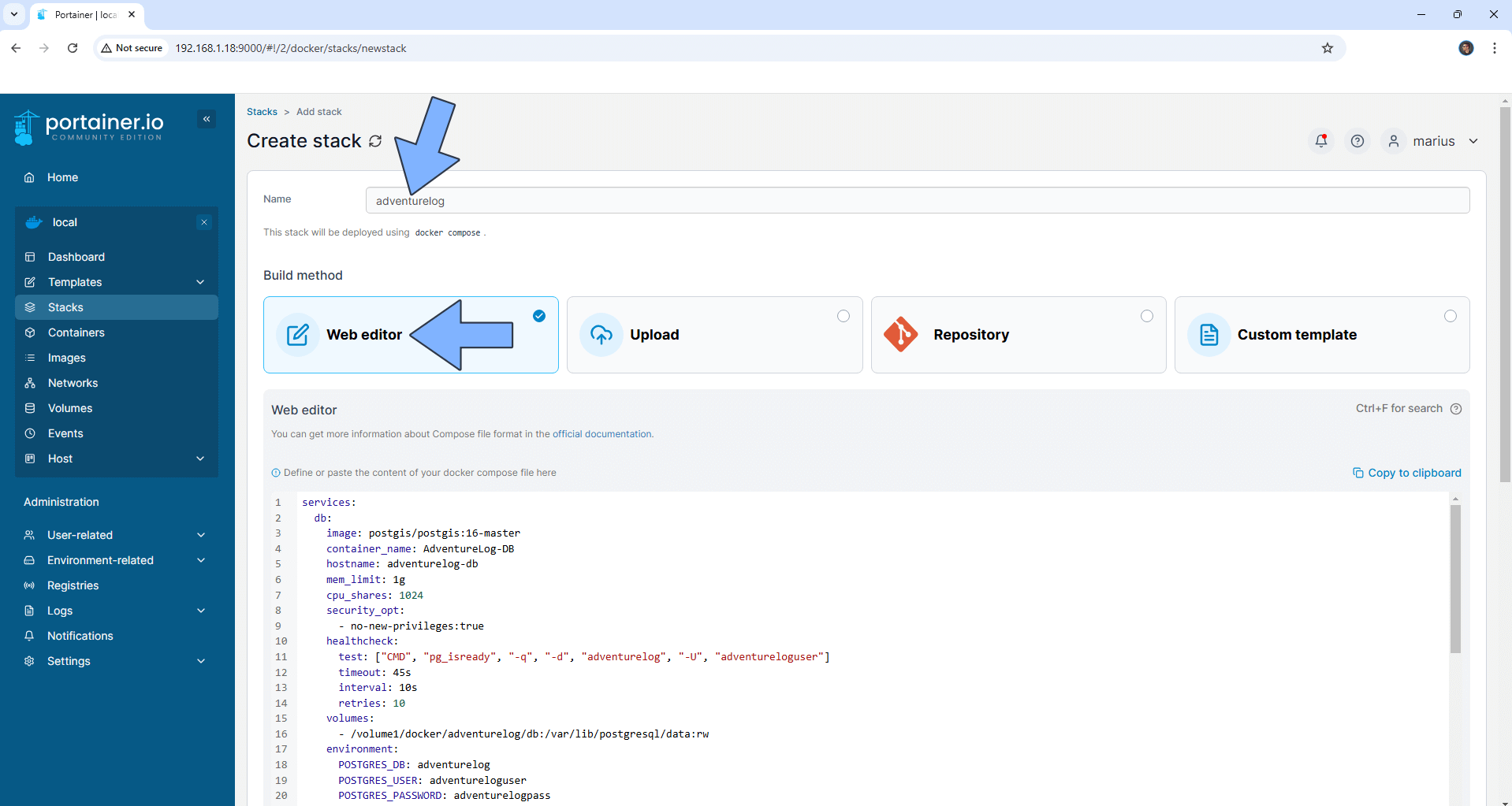
STEP 18
Scroll down on the page until you see a button named Deploy the stack. Click on it. Follow the instructions in the image below. The installation process can take up to a few minutes. It will depend on your Internet speed connection.
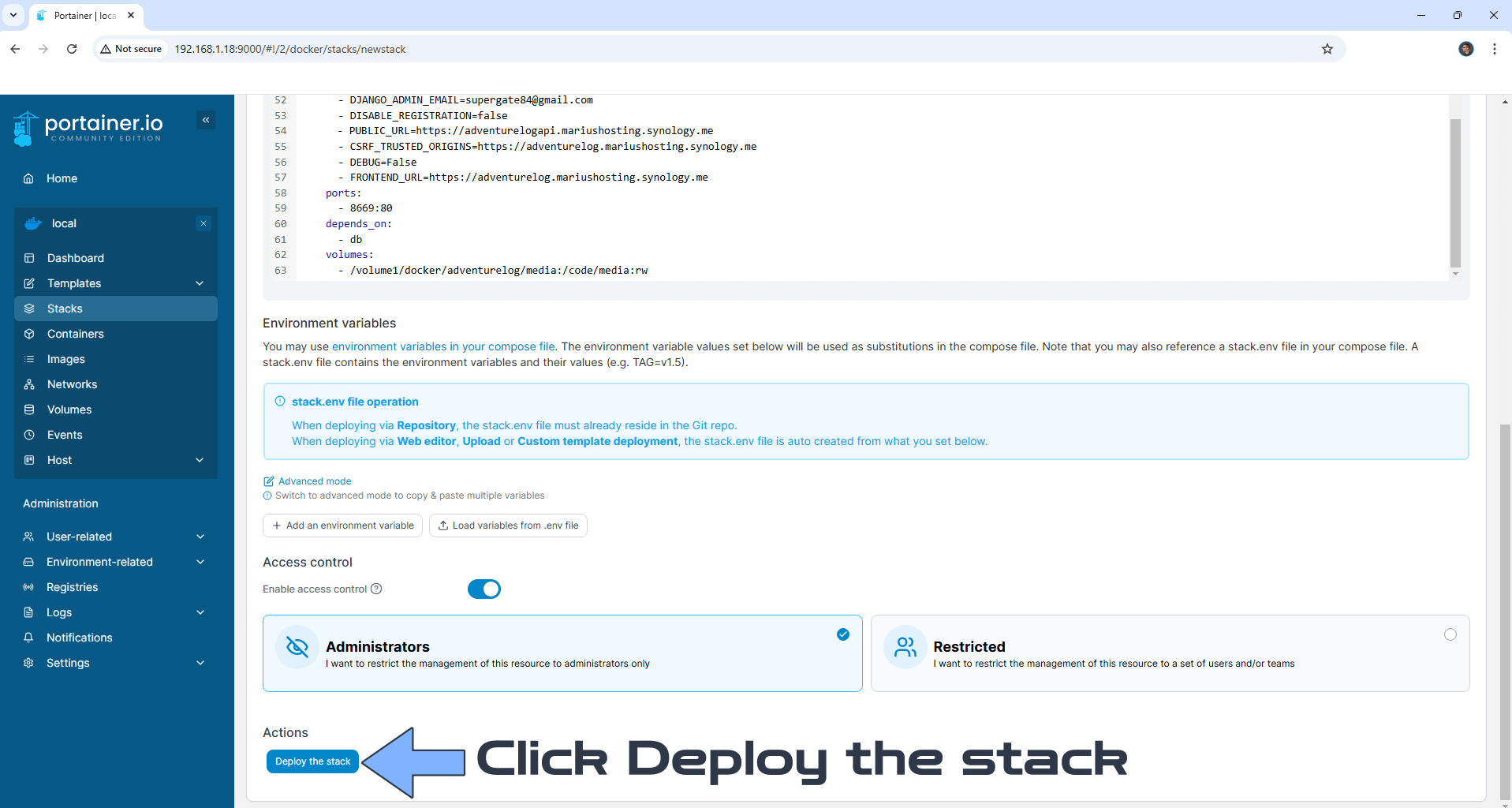
STEP 19
If everything goes right, you will see the following message at the top right of your screen: “Success Stack successfully deployed“.

STEP 20
On the left sidebar in Portainer, click Containers. Identify your AdventureLog-SERVER instance, then click on the little terminal icon. Follow the instructions in the image below.
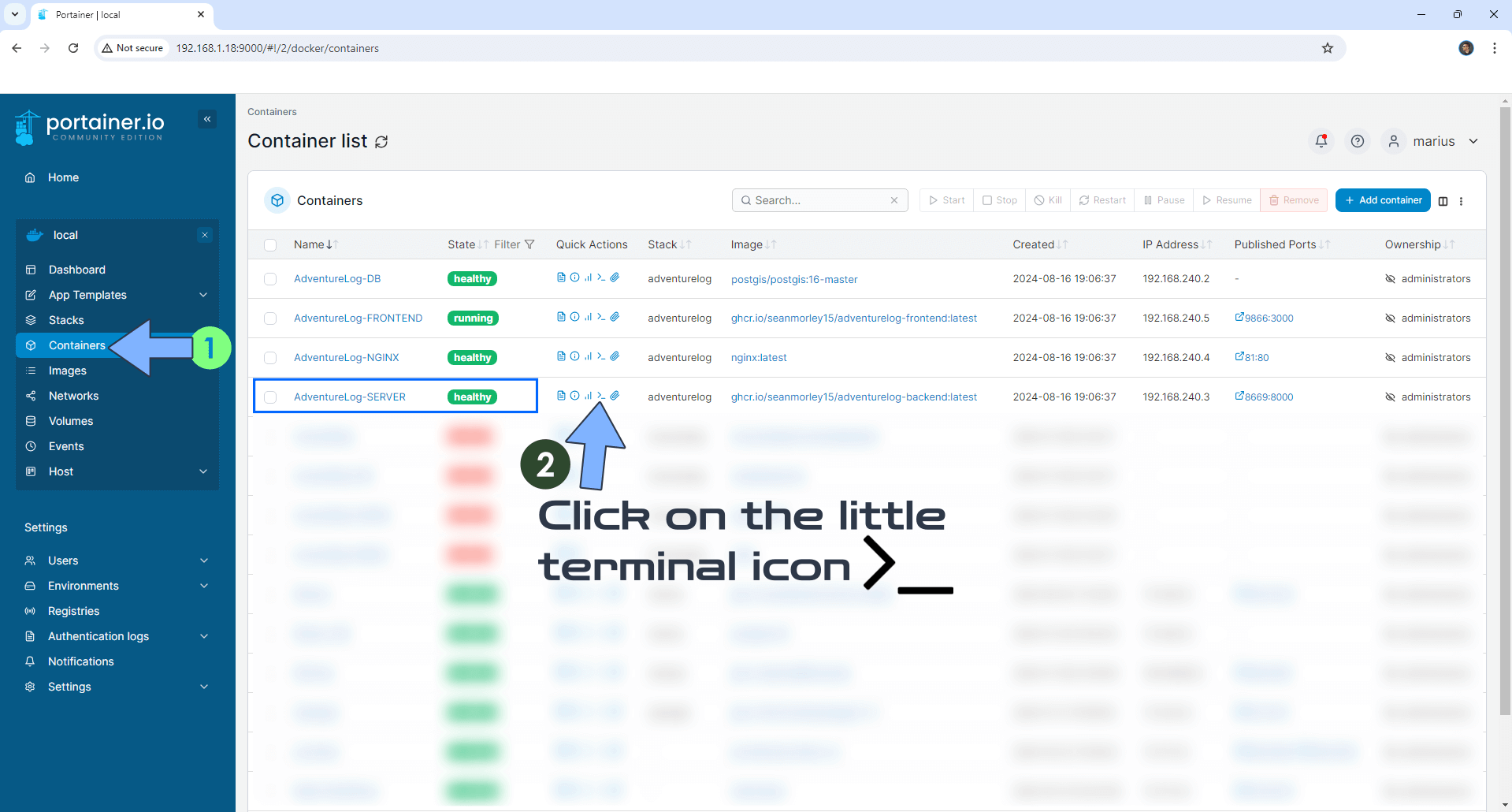
STEP 21
After you click on the little terminal icon at STEP 20, a new page will open. Click Connect. Follow the instructions in the image below.
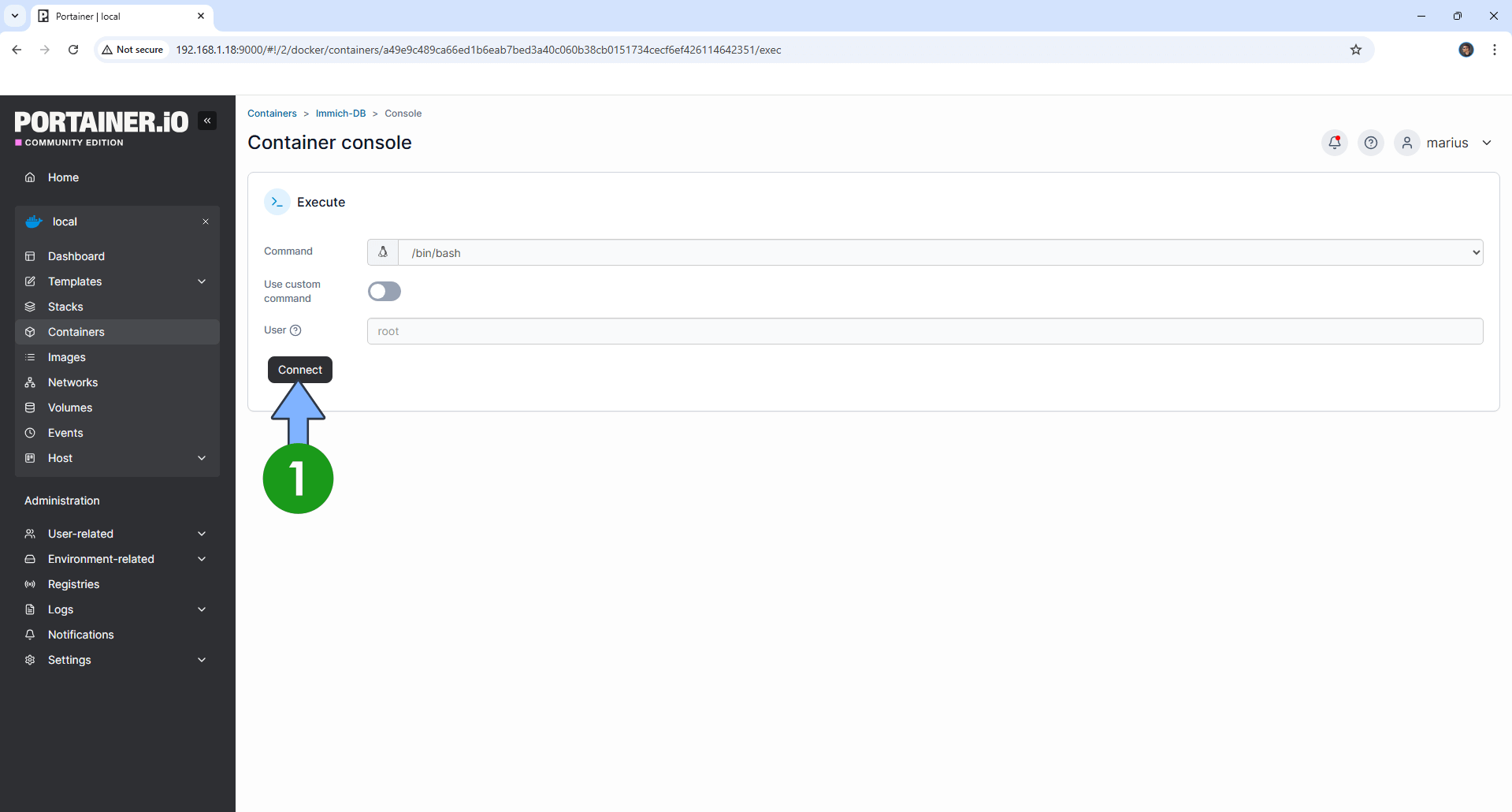
STEP 22
After you click Connect at STEP 21, a Console will open. Copy Paste the code below, then hit Enter on your keyboard. Follow the instructions in the image below.
python manage.py download-countries
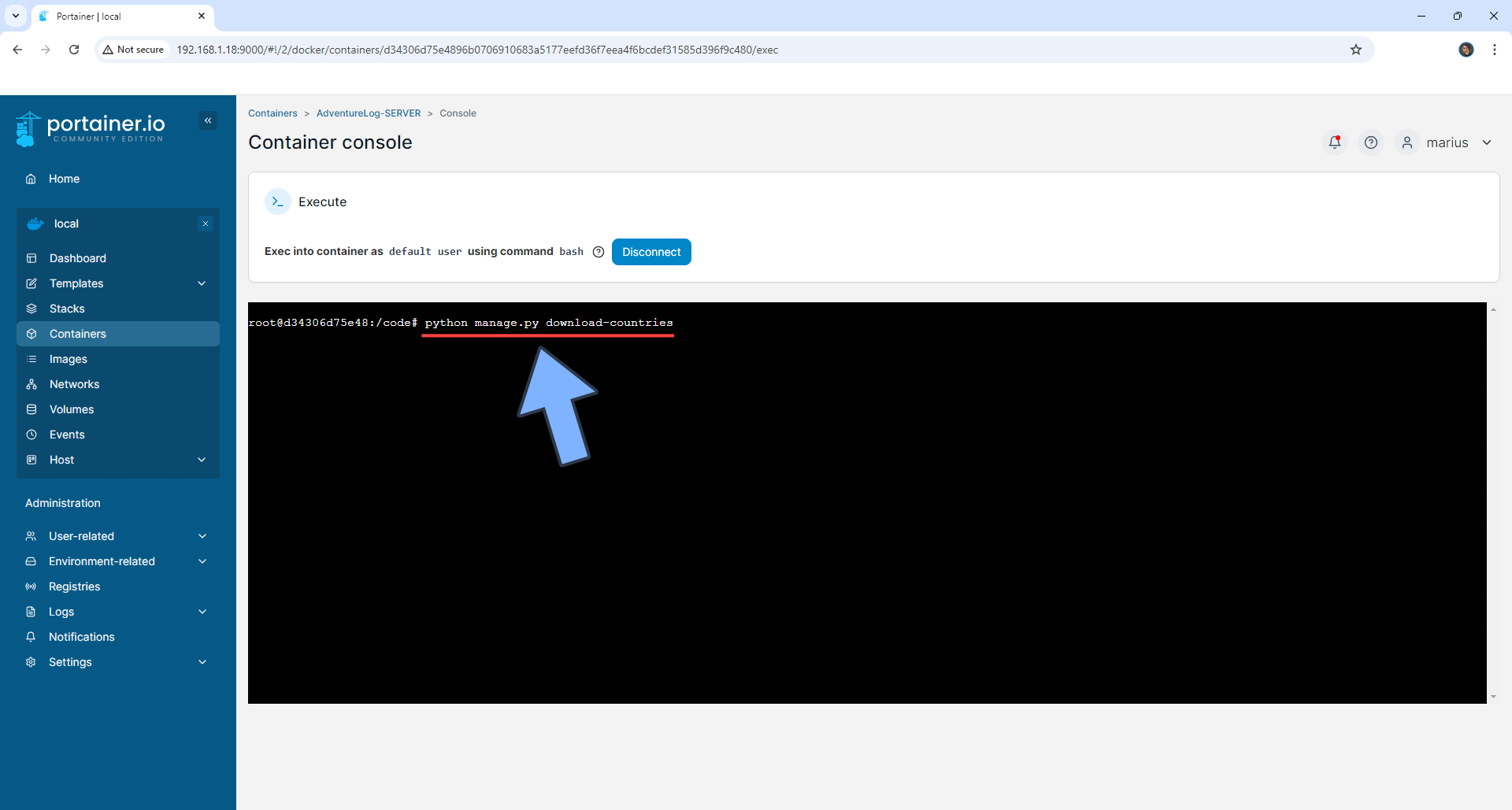
STEP 23
The World Travel Data will be downloaded. If everything goes right, you will see the following message at the end of the console: “All data imported successfully“.
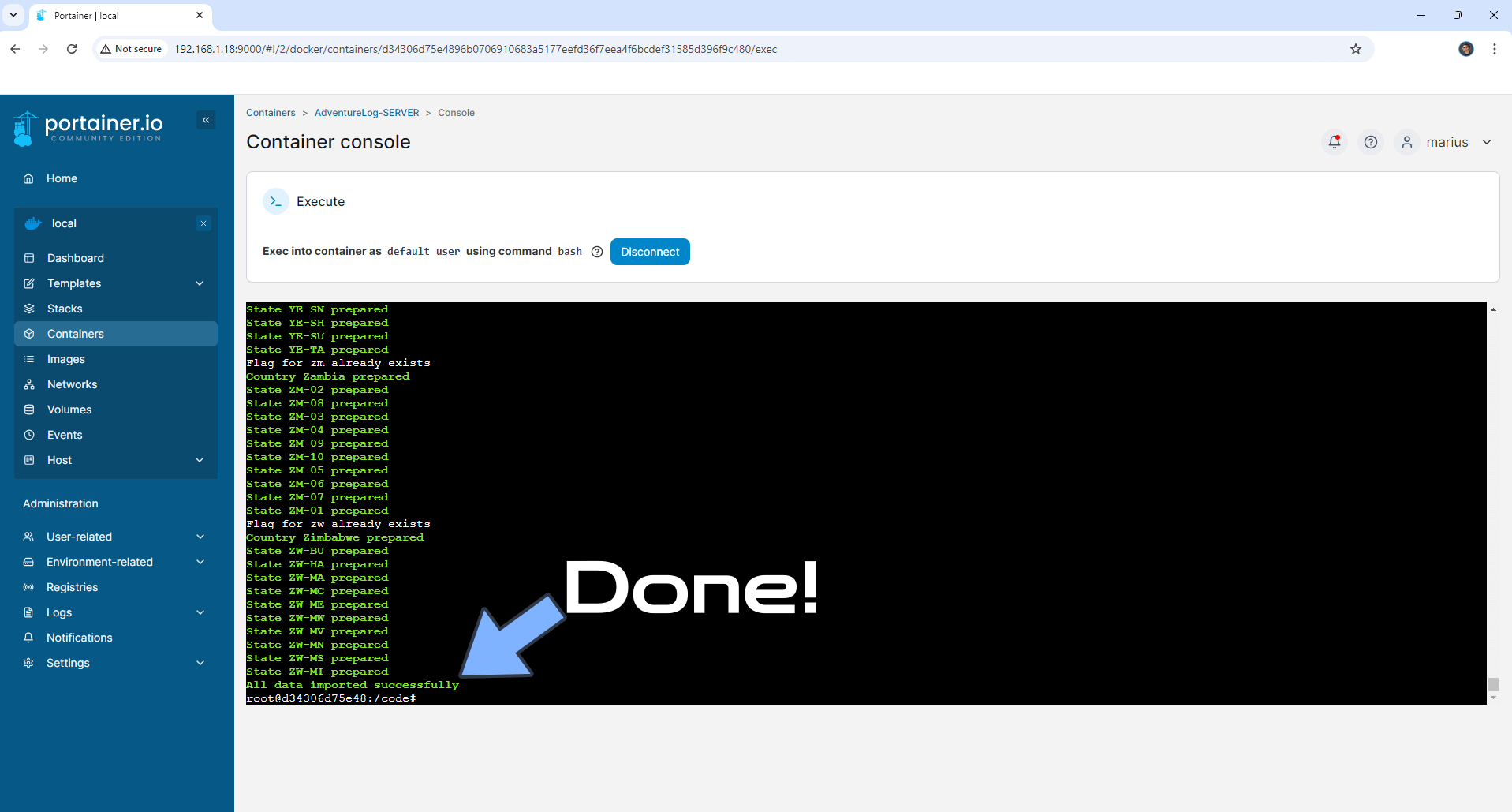
STEP 24
🟢Please Support My work by Making a Donation. Almost 99,9% of the people that install something using my guides forget to support my work, or just ignore STEP 1. I’ve been very honest about this aspect of my work since the beginning: I don’t run any ADS, I don’t require subscriptions, paid or otherwise, I don’t collect IPs, emails, and I don’t have any referral links from Amazon or other merchants. I also don’t have any POP-UPs or COOKIES. I have repeatedly been told over the years how much I have contributed to the community. It’s something I love doing and have been honest about my passion since the beginning. But I also Need The Community to Support me Back to be able to continue doing this work.
STEP 25
Now open your browser and type in your HTTPS/SSL certificate like this https://adventurelog.yourname.synology.me that you have previously created at STEP 8. In my case it’s https://adventurelog.mariushosting.synology.me If everything goes right, you will see the AdventureLog homepage. At the top right of the page, click the 3 horizontal dots, then select your favorite theme. Click Sign Up to create an account. Follow the instructions in the image below.
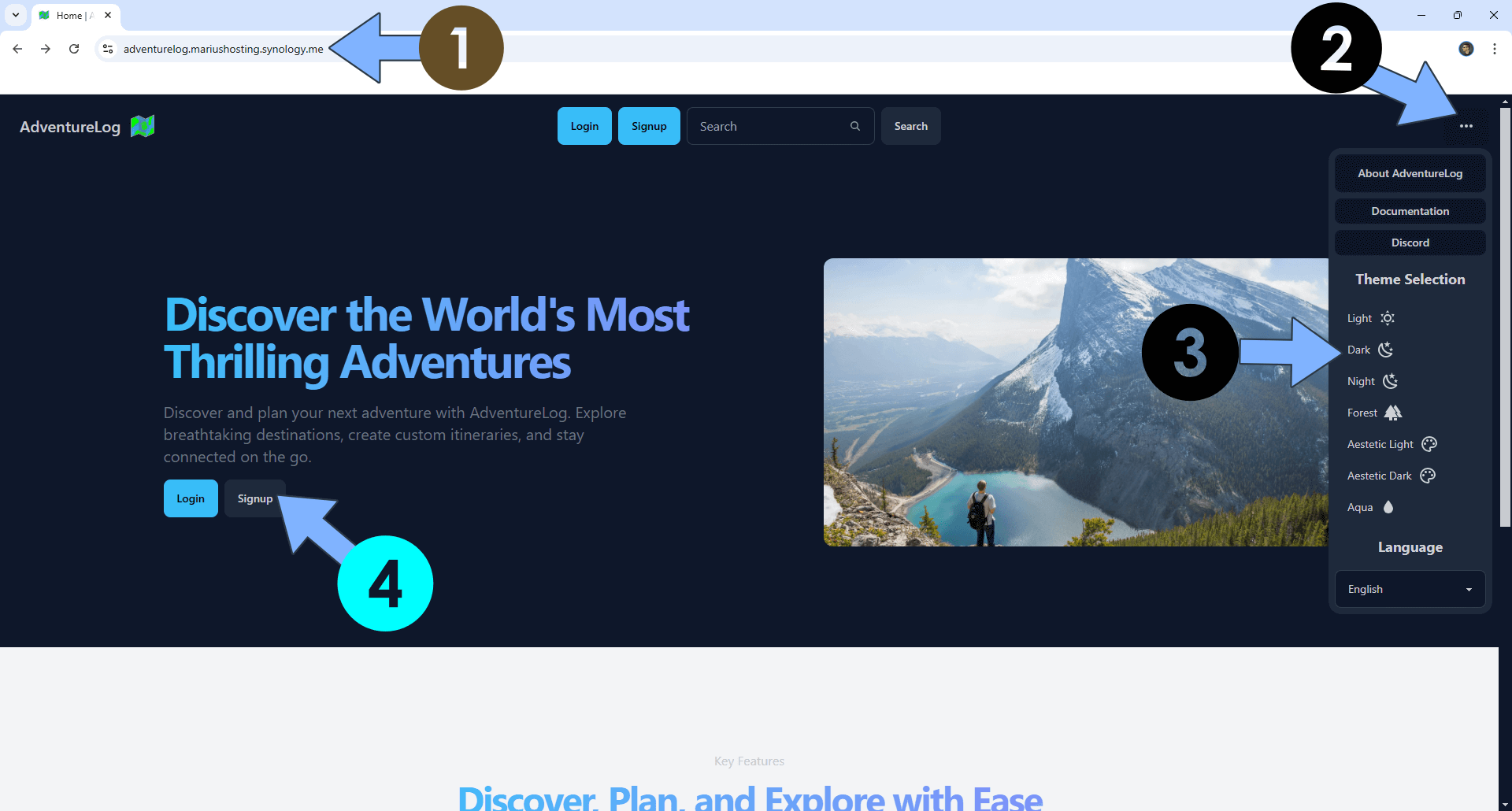
STEP 26
Type in your own details, then click Signup. Follow the instructions in the image below.
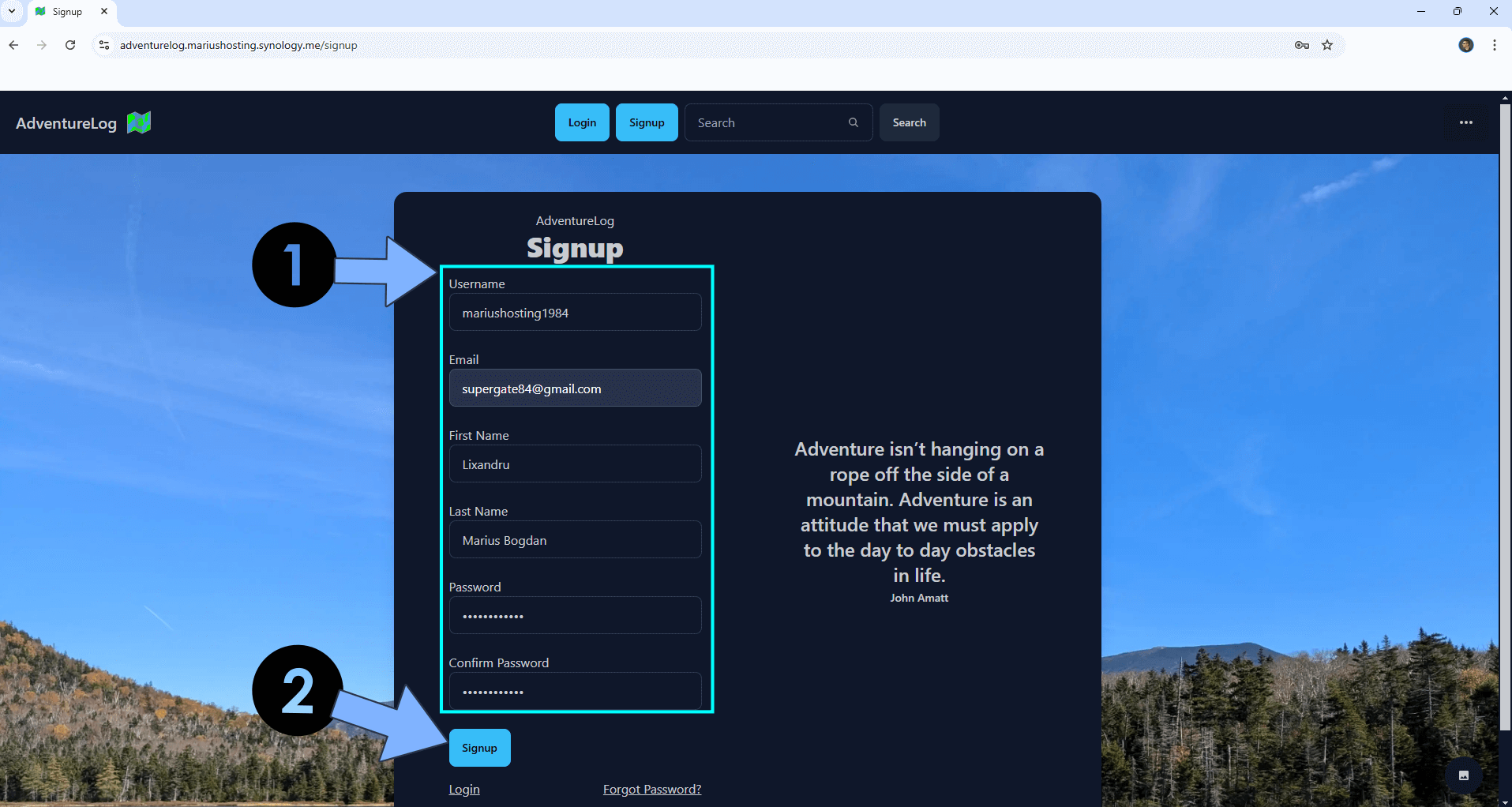
STEP 27
Welcome to the AdventureLog homepage! Go straight to the next STEP.
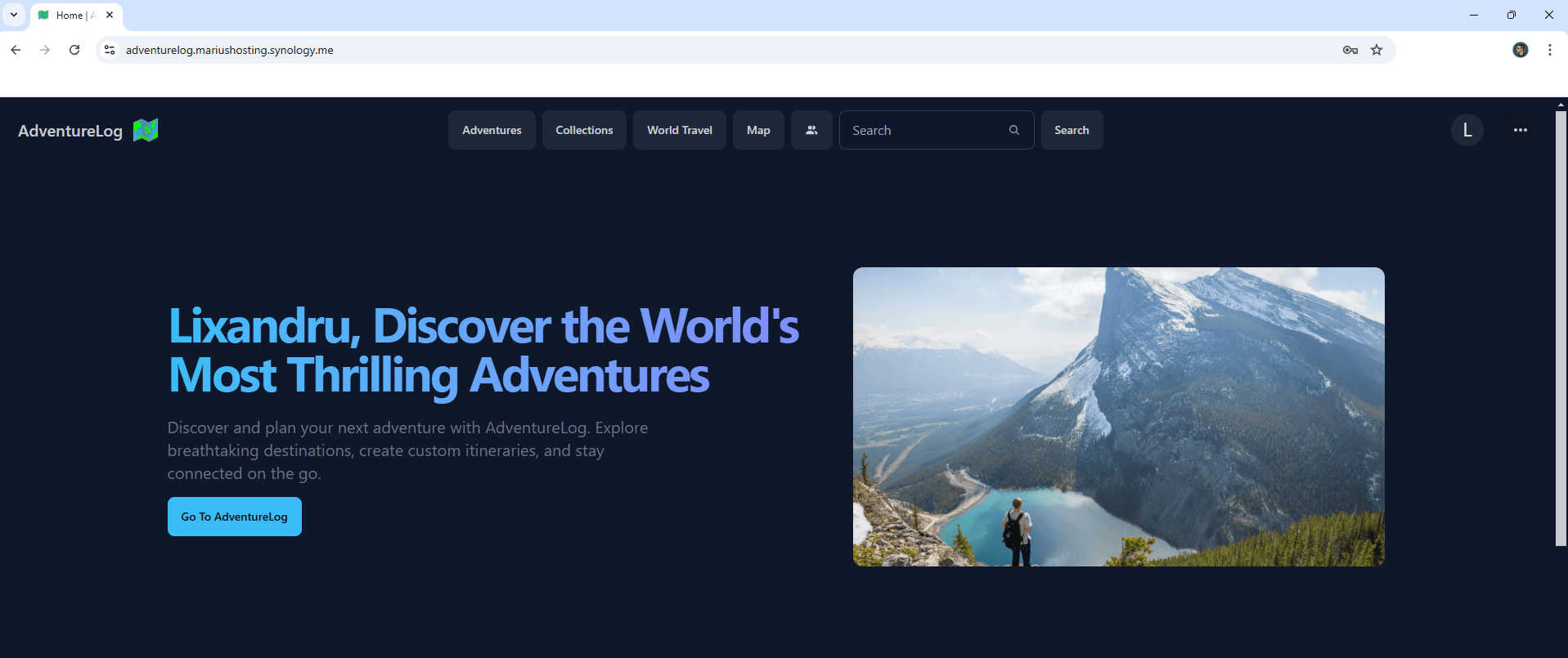
STEP 28
At the top right of the page, click on the user icon then My Adventures. Click the + button at the bottom right of the page. Follow the instructions in the image below.

STEP 29
Click Visited Adventure if you want to add memorial tracks of your previous adventure or Planned Adventure for an upcoming Vacation/Adventure. I selected Visited Adventure. Follow the instructions in the image below.
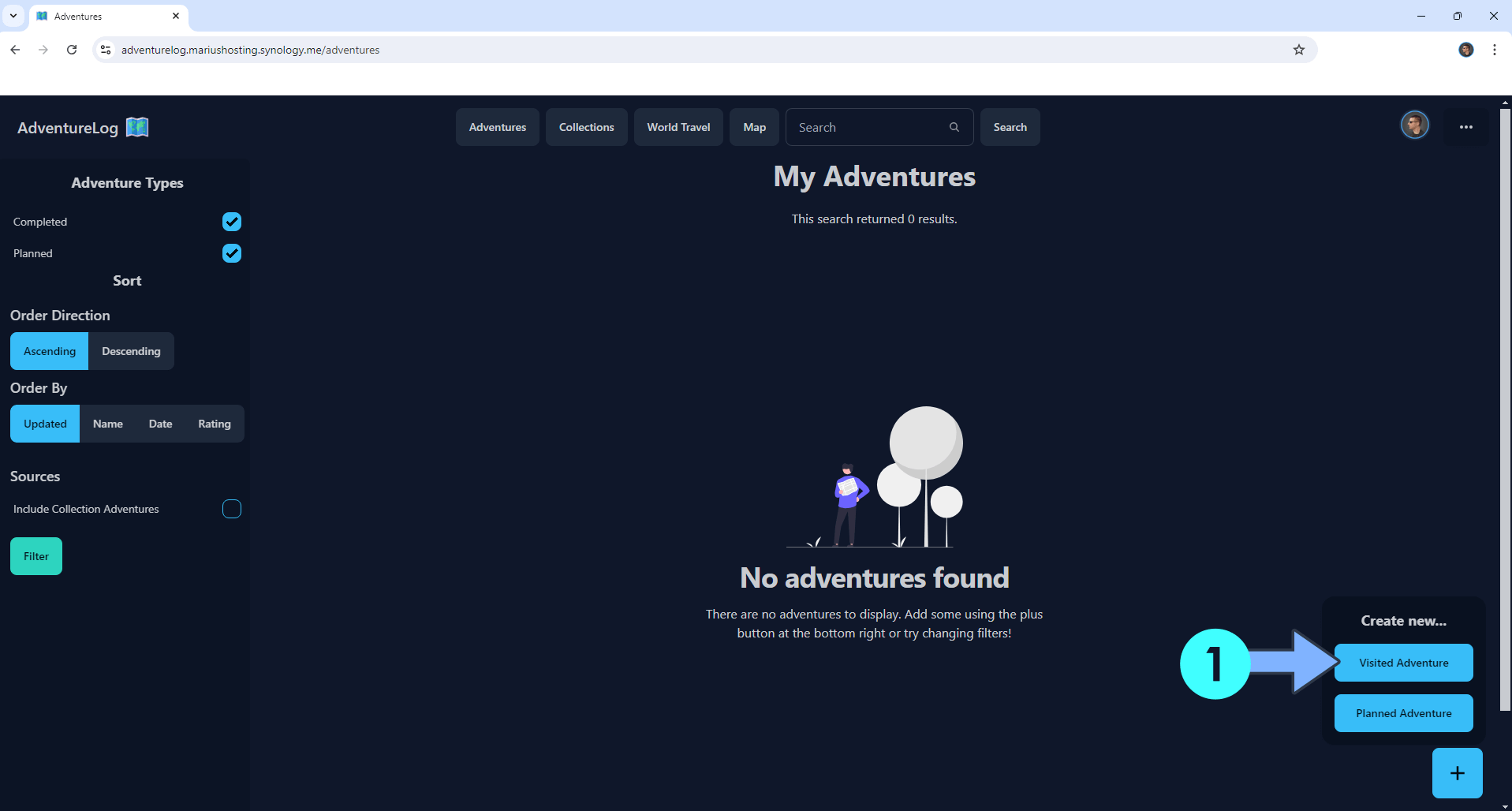
STEP 30
Add the details of your Adventure with image, if possible, then click Create. Follow the instructions in the image below.
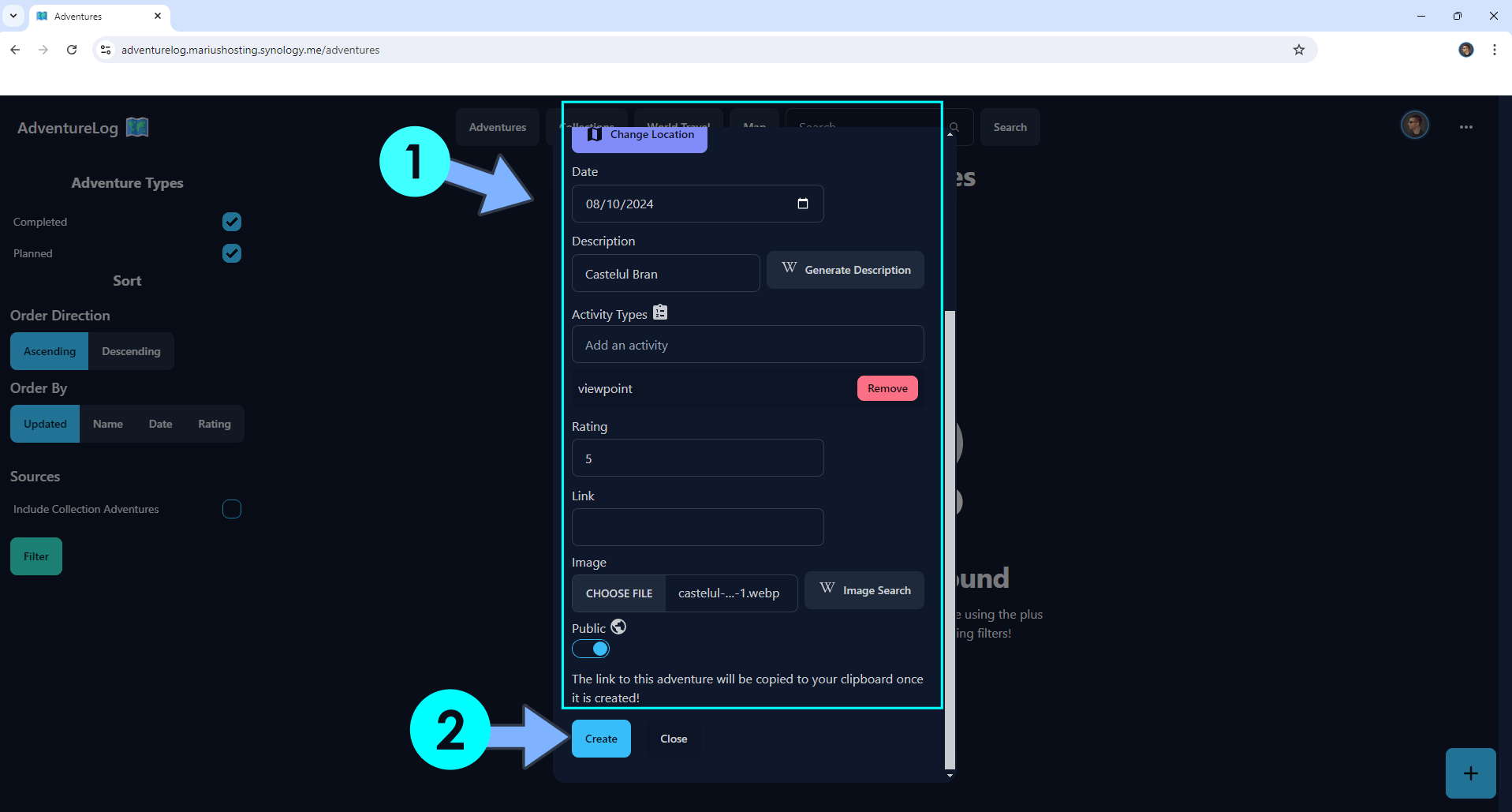
STEP 31
Your first Vacation/Adventure at a glance!
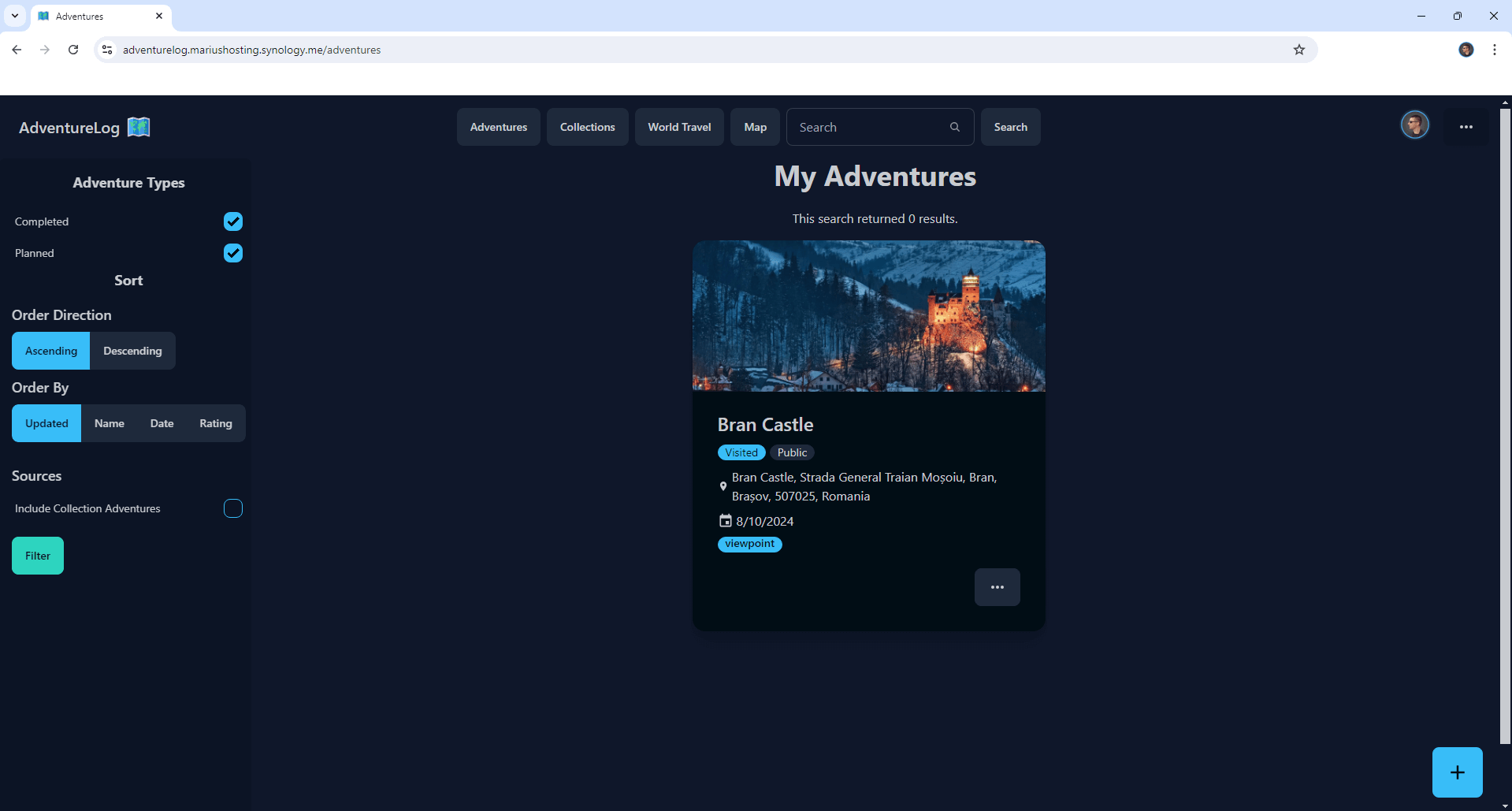
STEP 32
Add multiple Adventures!
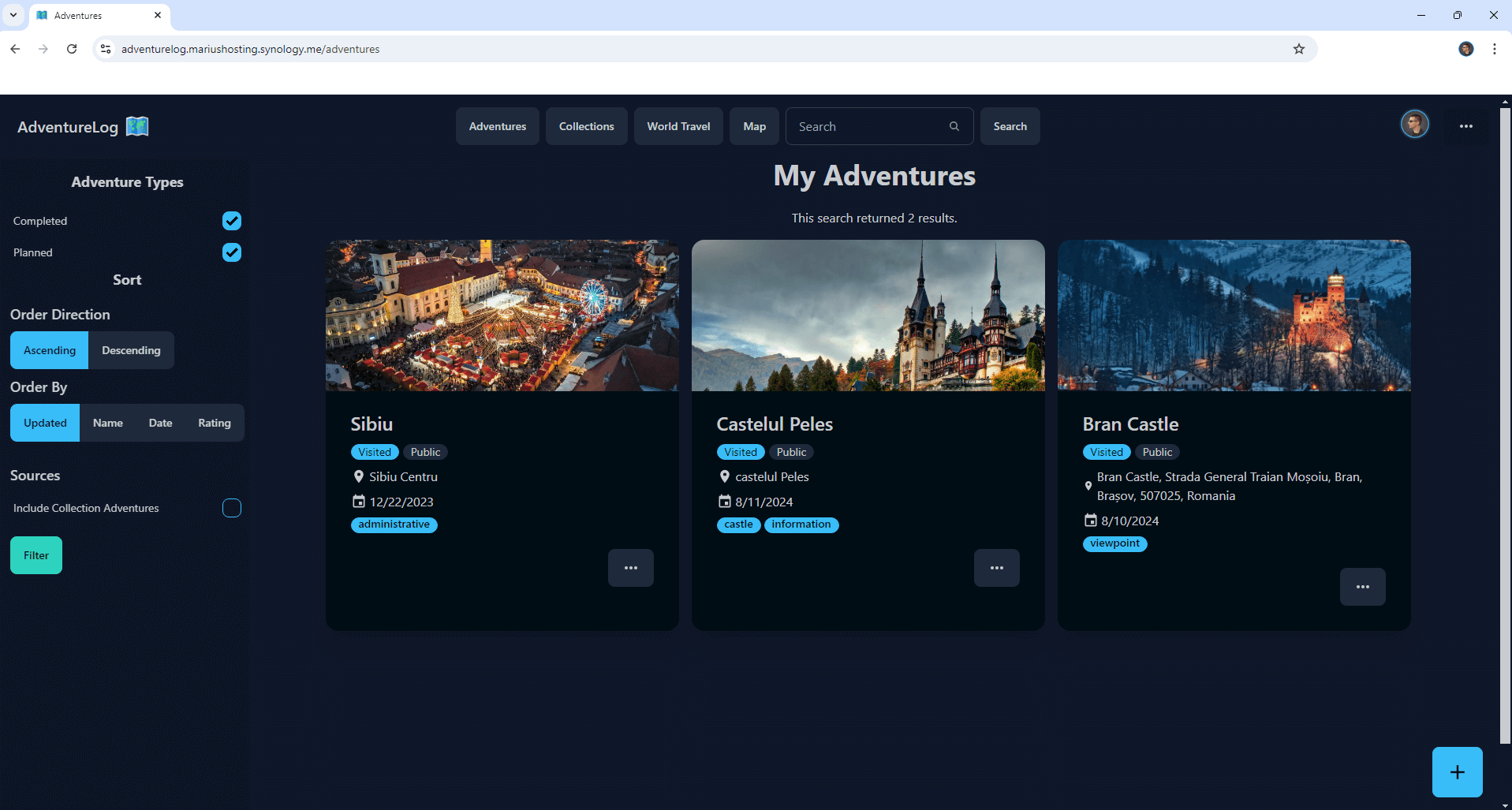
STEP 33
Your Adventures at a glance!

STEP 34
At the top of the page you can also click the Map tab to check your Pinned Adventures in a Worldwide map.
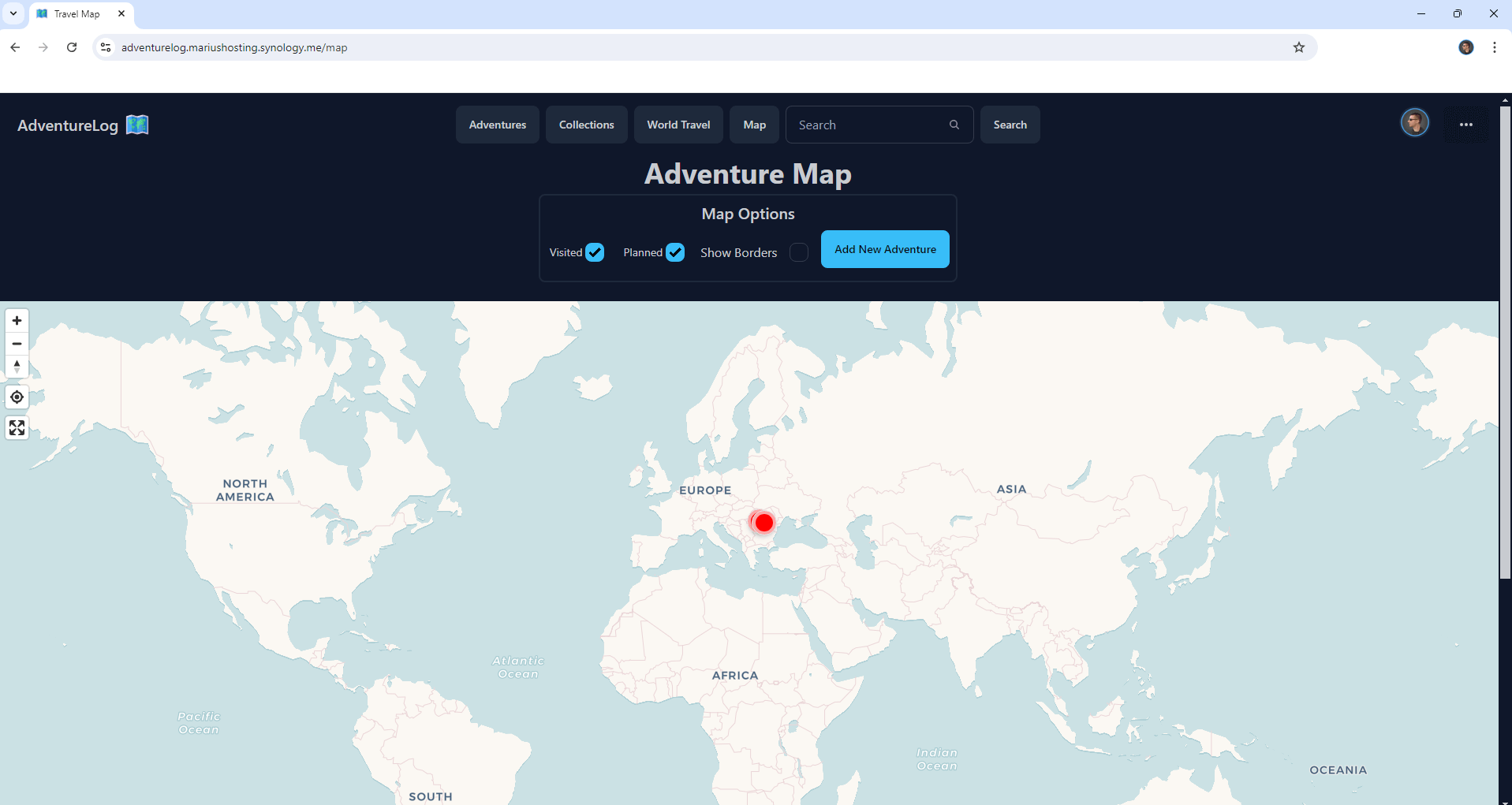
STEP 35
If you want to disable user registration in AdventureLog after registering the first user, just change the following line in the compose at STEP 17:
DISABLE_REGISTRATION=falsewith the following one:
DISABLE_REGISTRATION=trueClick update the stack to update the settings. From this point on, any user that will try to register a new account in AdventureLog will be rejected.
Enjoy AdventureLog!
If you encounter issues by using this container, make sure to check out the Common Docker issues article.
Note: Can I run Docker on my Synology NAS? See the supported models.
Note: How to Back Up Docker Containers on your Synology NAS.
Note: Find out how to update the AdventureLog container with the latest image.
Note: How to Free Disk Space on Your NAS if You Run Docker.
Note: How to Schedule Start & Stop For Docker Containers.
Note: How to Activate Email Notifications.
Note: How to Add Access Control Profile on Your NAS.
Note: How to Change Docker Containers Restart Policy.
Note: How to Use Docker Containers With VPN.
Note: Convert Docker Run Into Docker Compose.
Note: How to Clean Docker.
Note: How to Clean Docker Automatically.
Note: Best Practices When Using Docker and DDNS.
Note: Some Docker Containers Need WebSocket.
Note: Find out the Best NAS Models For Docker.
Note: Activate Gmail SMTP For Docker Containers.
This post was updated on Friday / September 5th, 2025 at 3:18 PM
